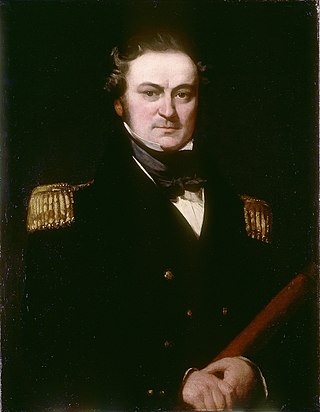Notes
- ↑ "SS Hecla (+1855)". wrecksite.eu. Retrieved 23 December 2021.
SS Hecla may refer to the following ships:

Sir William Edward Parry was an Royal Navy officer and explorer best known for his 1819–1820 expedition through the Parry Channel, probably the most successful in the long quest for the Northwest Passage, until it was finally negotiated by Roald Amundsen in 1906. In 1827, Parry attempted one of the earliest expeditions to the North Pole. He reached 82° 45' N, setting a record for human exploration Farthest North that stood for nearly five decades before being surpassed at 83° 20' N by Albert Hastings Markham in 1875.

The Hecla class formed the backbone of the Royal Navy's ocean survey fleet from the mid-1960s.

HMS Hecla was the lead ship of the Hecla class, an oceangoing survey ship type in the Royal Navy. She was ordered in the mid-1960s, along with her sister ships HMS Hecate and HMS Hydra. A fourth ship, HMS Herald, was completed in the early 1970s. The ship served for thirty years in this role, and various others, before finally being replaced by HMS Scott in 1997. Hecla was sold to private interests, being renamed "Bligh" after Vice-Admiral William Bligh. After this, the vessel was used in a hydrographic survey of Irish waters, and was based in Waterford, Ireland.
Six ships of the Royal Navy have been named HMS Tyne, after the River Tyne, England:
Seven ships of the Royal Navy have been named HMS Hecla, after the volcano Hekla in Iceland.

HMS Hecla was a Royal Navy Hecla-class bomb vessel launched in 1815. Like many other bomb vessels, she was named for a volcano, in this case Hekla in southern Iceland. She served at the Bombardment of Algiers in 1816. Subsequently, she took part in three expeditions to the Arctic. She then served as a survey vessel on the coast of West Africa until she was sold in 1831. She became a merchantman and in 1834 a Greenland whaler. She was wrecked in 1840.

HMS Fury was a Hecla-class bomb vessel of the British Royal Navy.

USS Xanthus (AR-19) was a Xanthus-class repair ship acquired by the United States Navy for the task of providing repairs to the fleet. She was named after Xanthus, a mythical beast of Greek legend.
SS William R. Cox may refer to one of three American Liberty ships named in honor of Civil War General William Ruffin Cox:
SS City of Honolulu may refer to one of these Los Angeles Steamship Company ships:
USS Hecla may refer to more than one United States Navy ship:
SS Ohioan may refer to one of two ships owned by the American-Hawaiian Steamship Company
Five ships of the Royal Navy have borne the name HMS Hecate, after Hecate, a goddess in early Greek mythology:
SS Tuxpam can refer to
Several naval ships were named Helgoland after the island of Heligoland or the Battle of Helgoland, an action during the Second Schleswig War.
A number of steamships were named Washingtonian, including:
SS Kronprinzessin Cecilie may refer to one of these ships:
SS Shahzada may refer to:
Five ships of the Royal Navy have been named HMS Beacon:
SS John Mitchell may refer to the following ships: